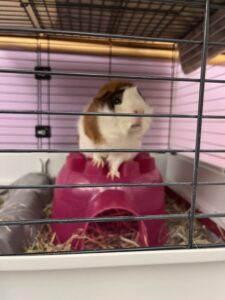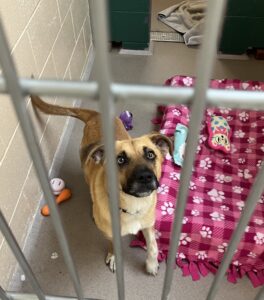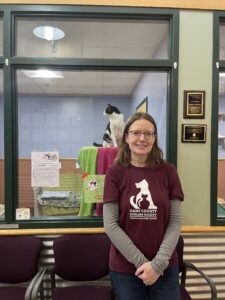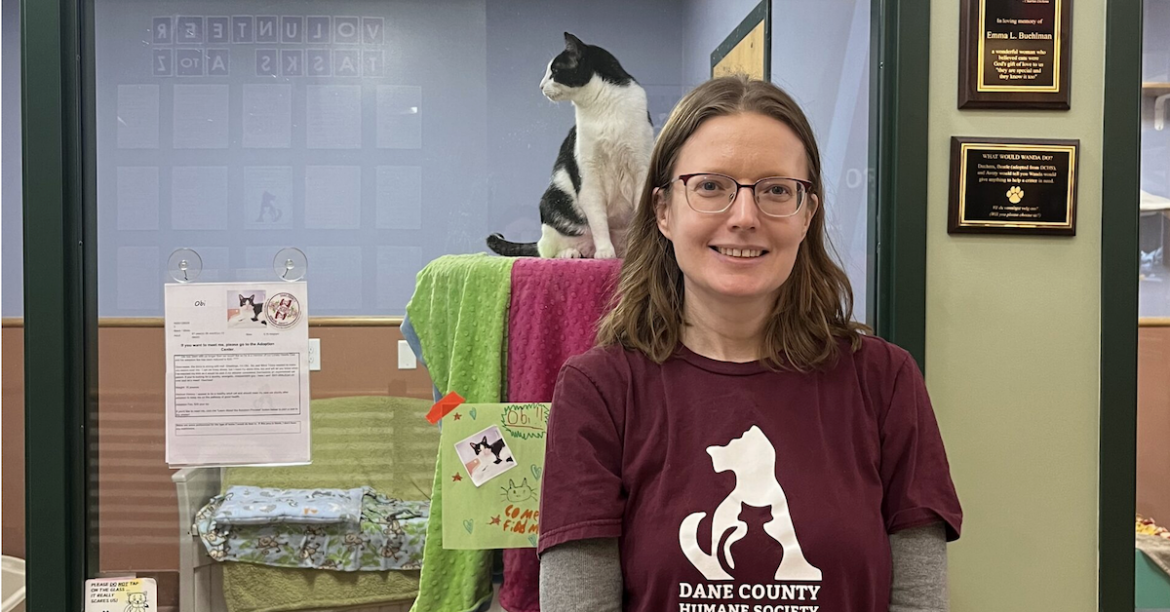The impact an animal can have on someone’s life is never-ending. They can offer comfort in times of need, be adventurous companions and, sometimes, even get you a job.
When Lisa Bernard, the current Dane County Humane Society public relations coordinator, was applying for her position, she was asked to come in to demonstrate her skills.
As Bernard worked on a writing piece and advertisement, a cat came out of the office across from her to say hi through the screen. The office spaces at the humane society are equipped with screen doors so that the animals can roam freely in the area and have some space away from the other animals as needed.
“My current boss came by and asked if everything was all right,” she said. She informed them that everything was fine, but that the cat across the way was very talkative. This response was met with a lot of surprise as her boss asked her, “This office cat? But nobody’s seen this cat? He hasn’t come out.”

“[My boss] left and [the cat] came back to the door,” Bernard said. “I think he got me my job because he was so chatty with me.”
The Dane County Humane Society is an independent, nonprofit agency that has been around for just over a century. It has roughly 115 employees, but this number is nothing compared to the number of volunteers — more than 950 — who give their time to the organization. Volunteers can work in the thrift store, file administrative paperwork or have a more pet-centered experience as “canine companions”, “feline friends” or “critter cuddlers”. It is thanks to this large-scale assistance that the humane society has been able to create and maintain a variety of programs and services for every pair of paws — and person — that steps through its door.
There are several ways that animals end up at the humane society. One way is through shelter transfers. This may be from other Wisconsin-based shelters or from as far away as Texas. This is usually due to overpopulation and a shortage of space in the other shelters.
Another way animals end up at the facility is when people surrender their pets. For some people, affordability and other extenuating factors make it hard to keep a pet. Its website does offer more information about this process; however, employees can also help find possible solutions.
“We know you love your pet. We know you want to stay with them,” Bernard said. “They want to stay with you too. So if there’s something we could talk about and help you with, we’re here to point you in the right direction.”
If there is a way for a pet to stay in its loving home, the humane society will work to make that happen. One instance of this could be the facility recommending vet clinics that charge cheaper prices for people who would otherwise have to surrender their pet due to vaccine costs.
The animals that do end up spending time at the shelter or in the humane society foster program don’t often stay there for long before they are adopted. However, that is not always the case.

According to Bernard, there has been an overall decrease in dog adoptions nationwide. This means that dogs are spending, on average, more time in the shelter before they do get adopted.
“Puppies used to go immediately, and now sometimes they spend a week,” she said. “It’s concerning, but at the same time, we’re still finding them homes. But the longer it takes them to find a home, it means we can’t bring in other animals.”
Bernard theorized that this dip in adoptions may be caused by the housing crisis or by new management companies taking over and changing the rules for pets.
That said, the humane society did create the “Lonely Hearts Club” for animals that have spent longer than average at the shelter without getting adopted.
All members of this club have reduced adoption fees and, thankfully, the adoption process for all the animals is easy.
“Some people think that we have a huge application process for adopting, and we don’t. All they ask is for you to fill out this small form that’s just your name, phone number and address,” said Bernard. “Then, they ask who you’re interested in meeting. Dogs, cats, if there is a specific animal.”
It is important to note that DCHS is far more than just a shelter; it is also a resource center.

“Just because the animal has left the building doesn’t mean that we’re no longer here for them,” she said. “We will always be here for them and their pet parents for whatever they need.”
If someone needs help or support, they are welcome to reach out. They also advise adopters about the rule of threes while they are at the shelter. This has to do with allowing the pet time to adjust to being in a new place.
“It takes them three days to realize they’re not in a shelter setting anymore. It takes them three weeks to learn your routine. And by three months, they know they’re home,” she said.
For Bernard, being a part of the humane society is much more than just work. It is a rewarding and fulfilling experience that gets to be shared, not only with the staff pets and new families, but the community as a whole as well.
“We’re happy that our community also feels that these animals deserve a second chance at happiness,” said Bernard. “Some have told me that they couldn’t work at DCHS because they would want to take every animal home. I know I can’t take each one home. So I’m doing the next best thing: sharing their stories to help them find new families. And when they do find their new home, I’m more than overjoyed for both the pet and their new family.”
For those who are interested, there are different ways to donate to the Dane County Humane Society. Its website has a section called “How to Help” that has all the information needed to donate or fulfill items on their wishlist. They also offer an option for people to design their own creative fundraising event.






